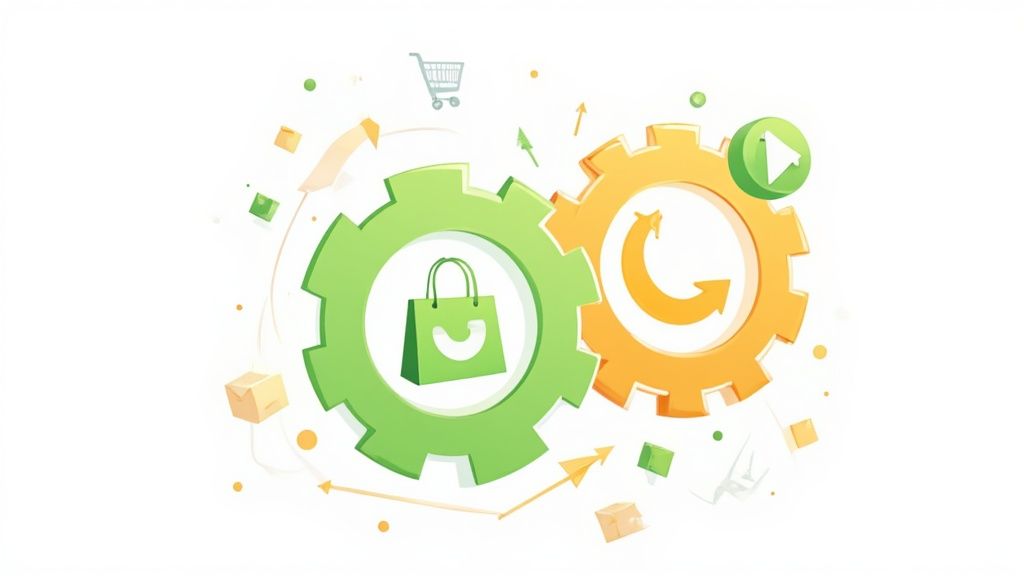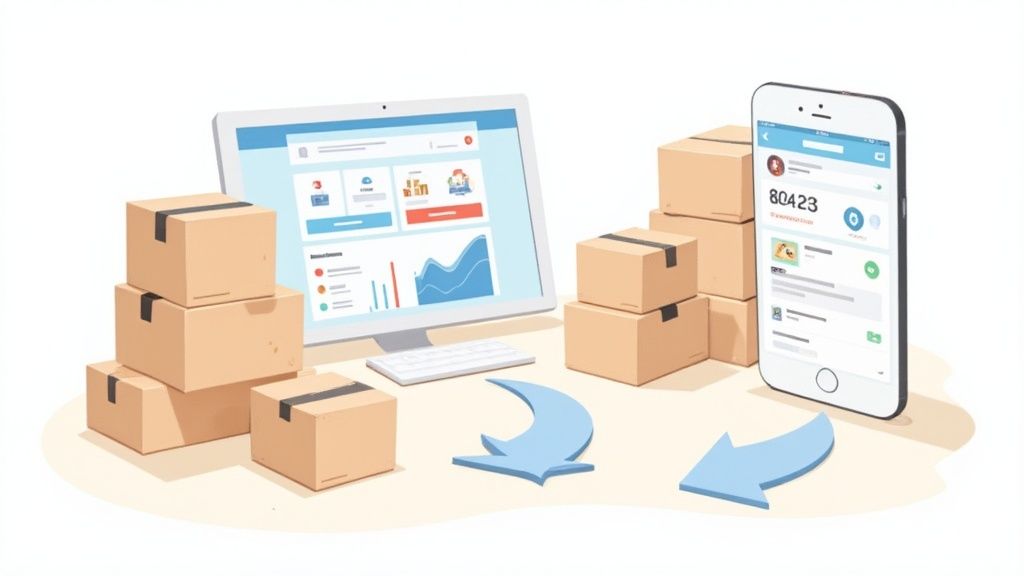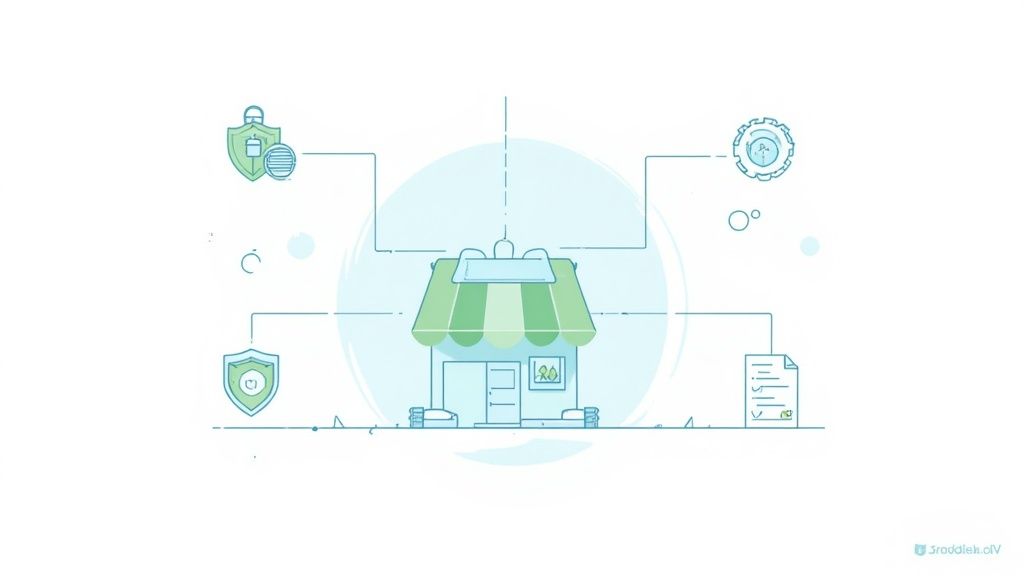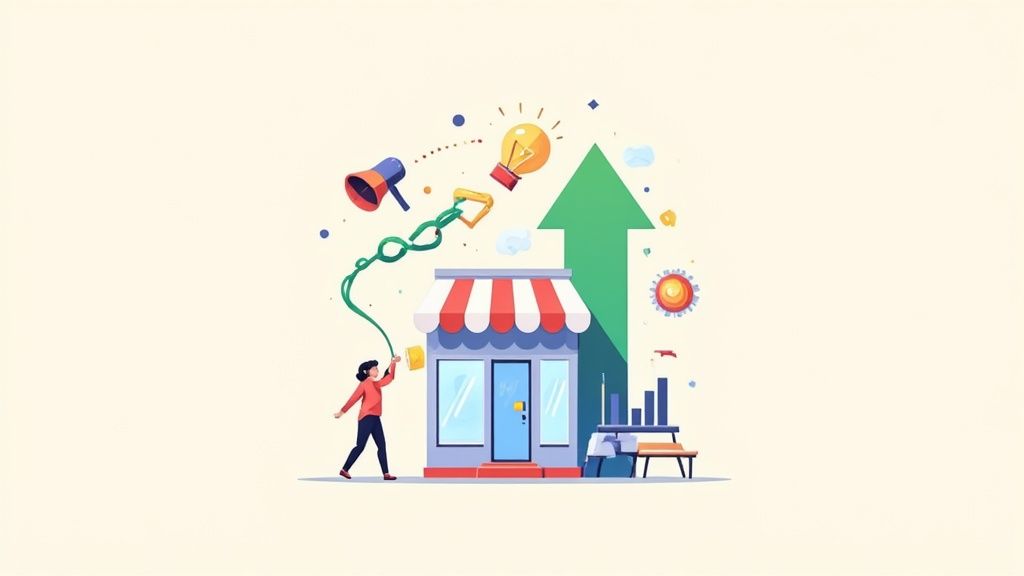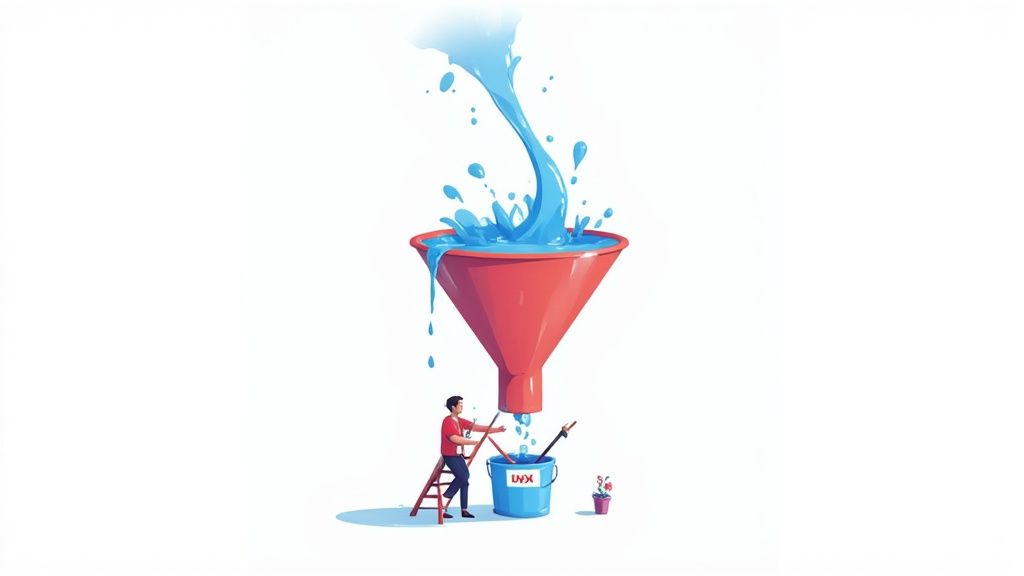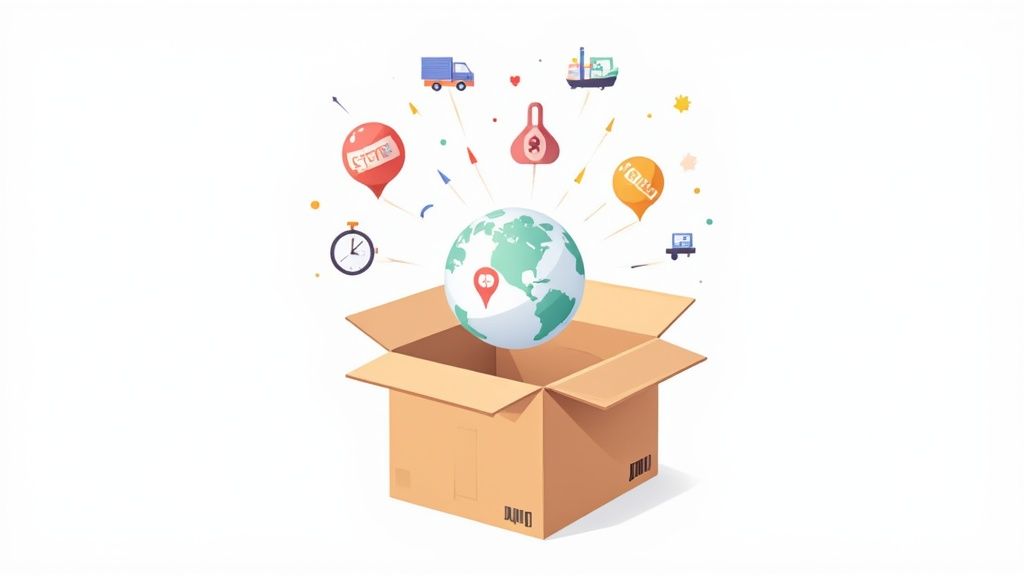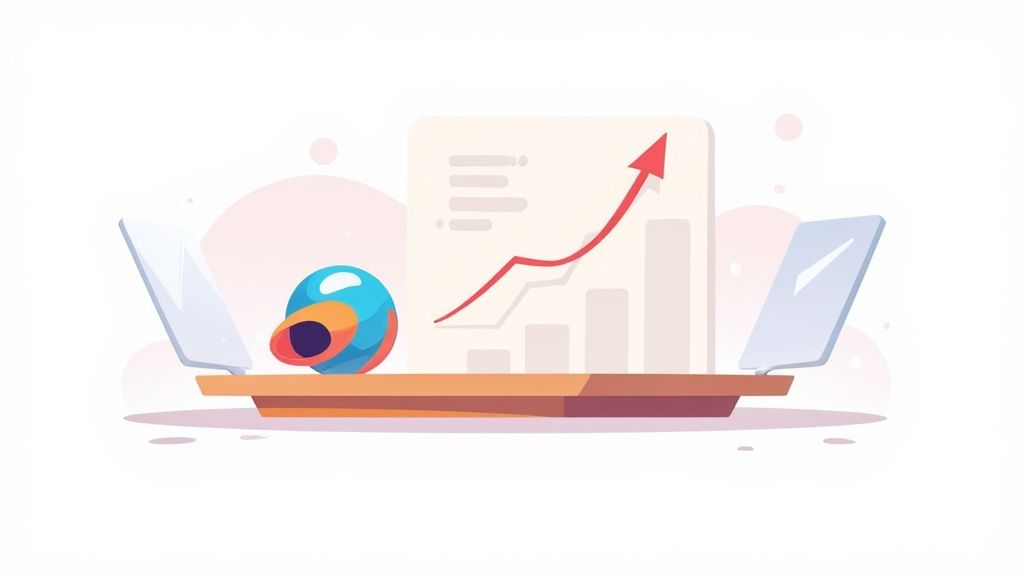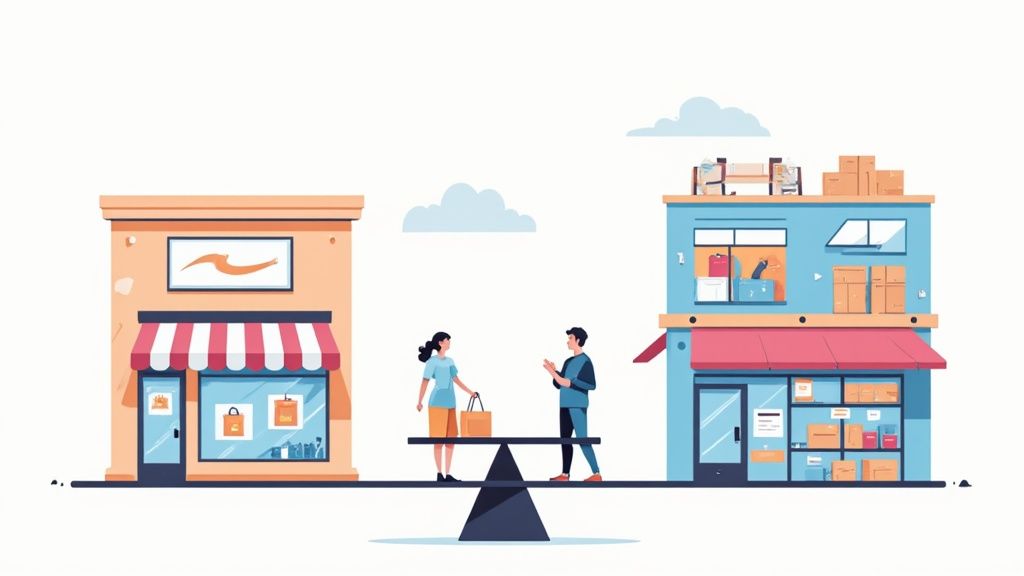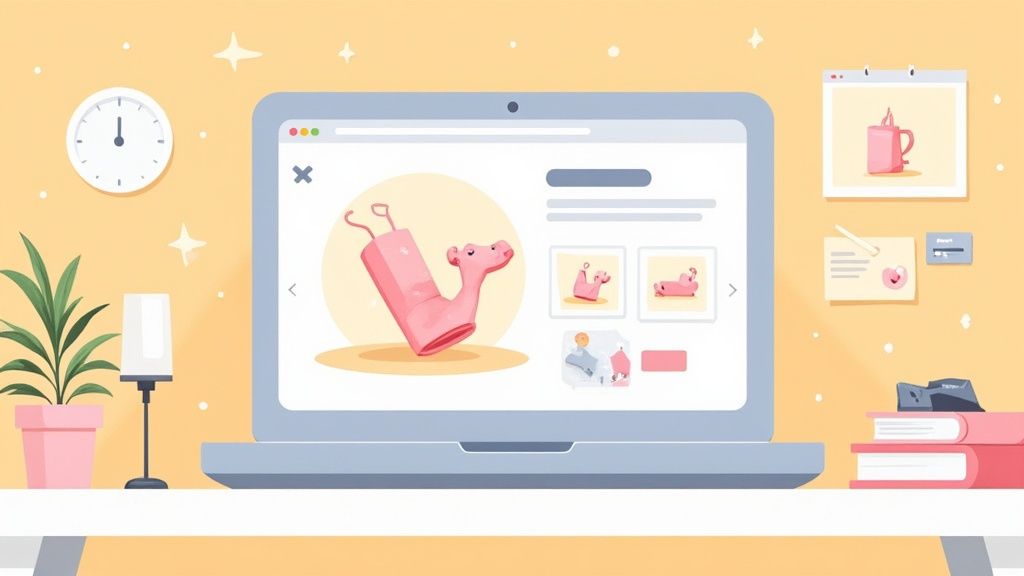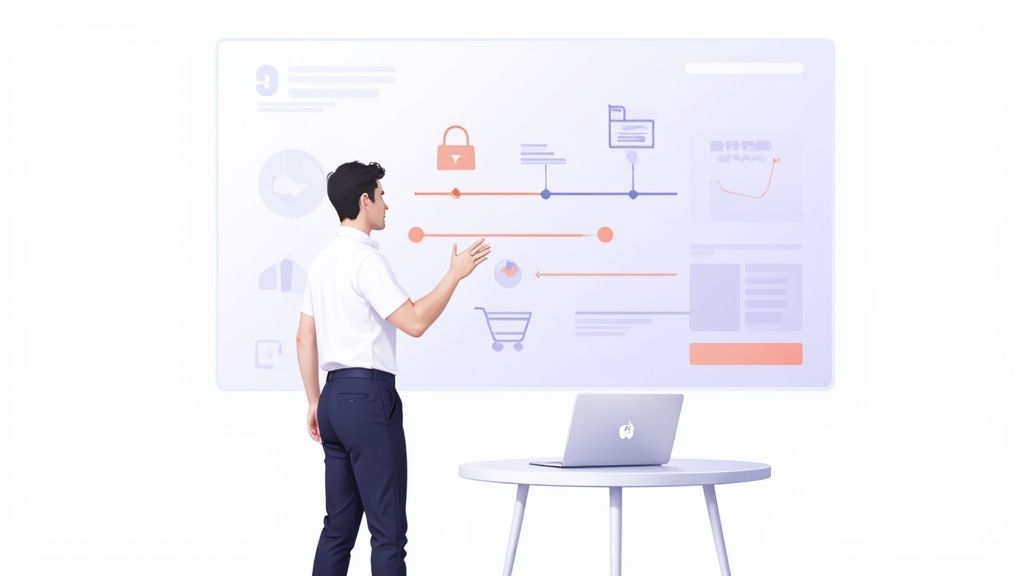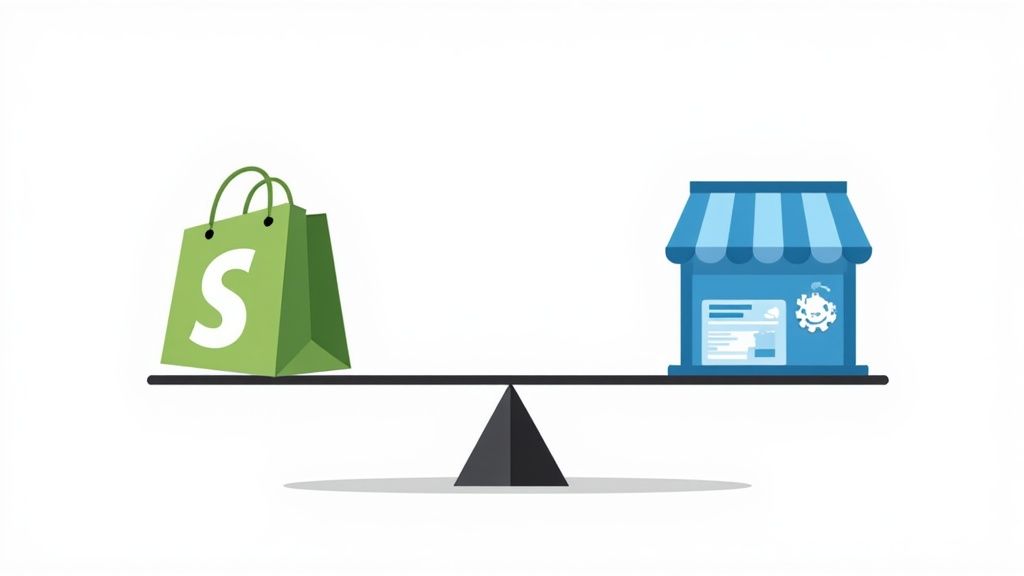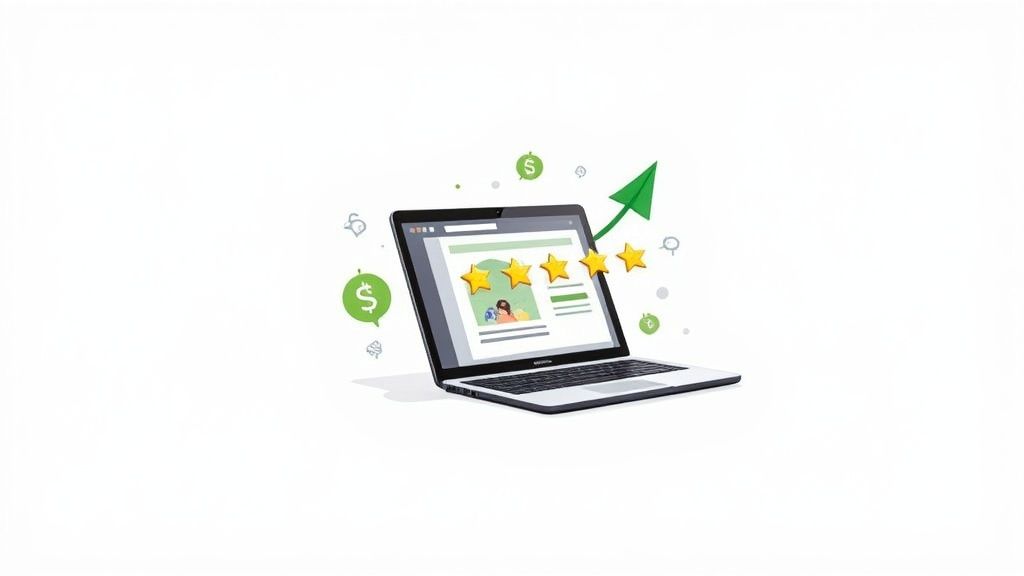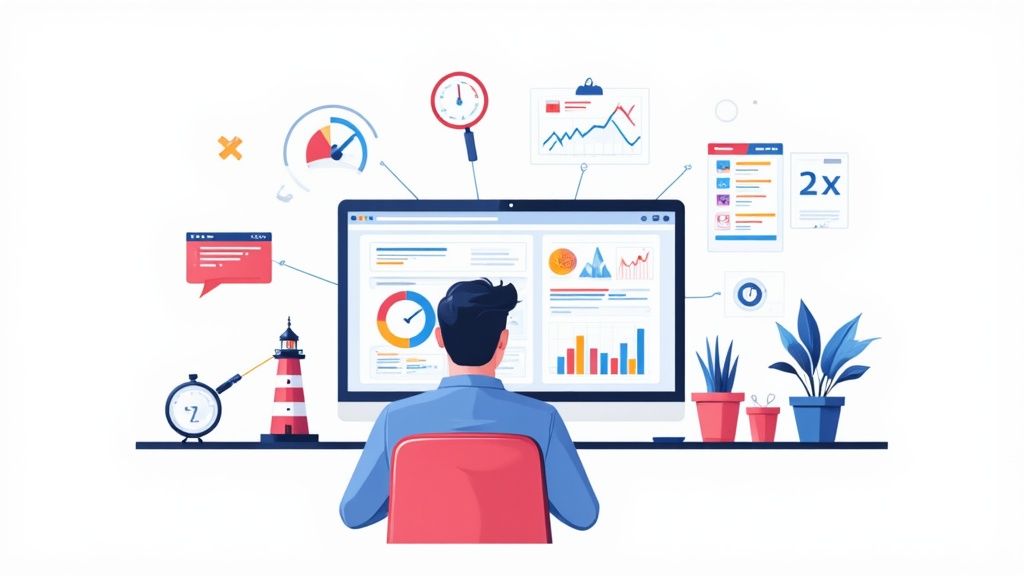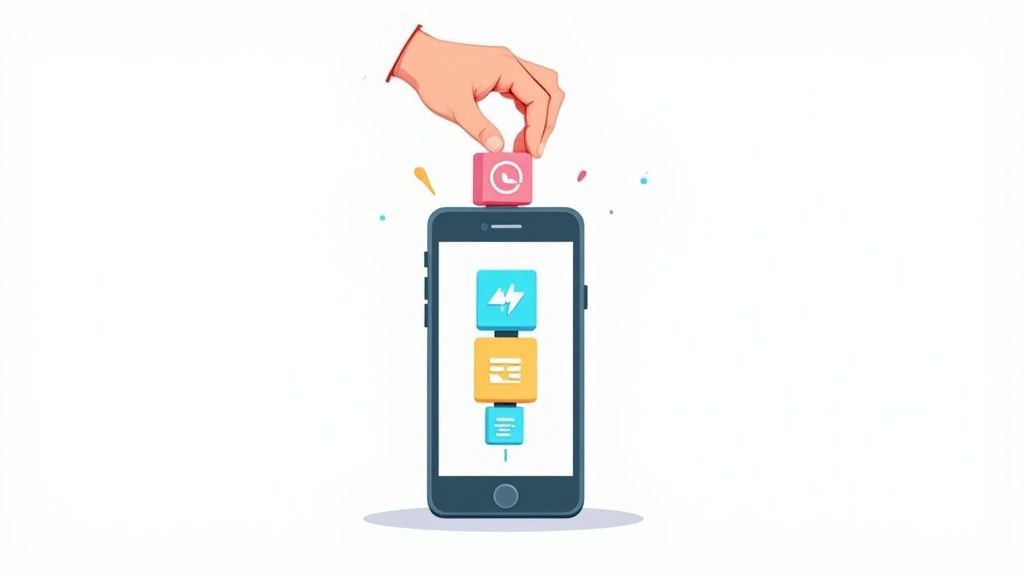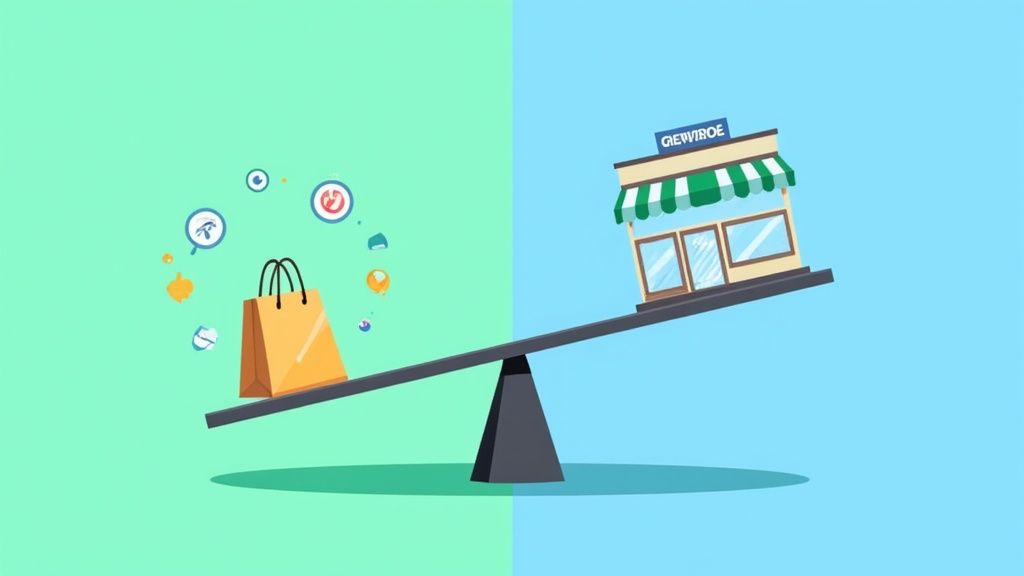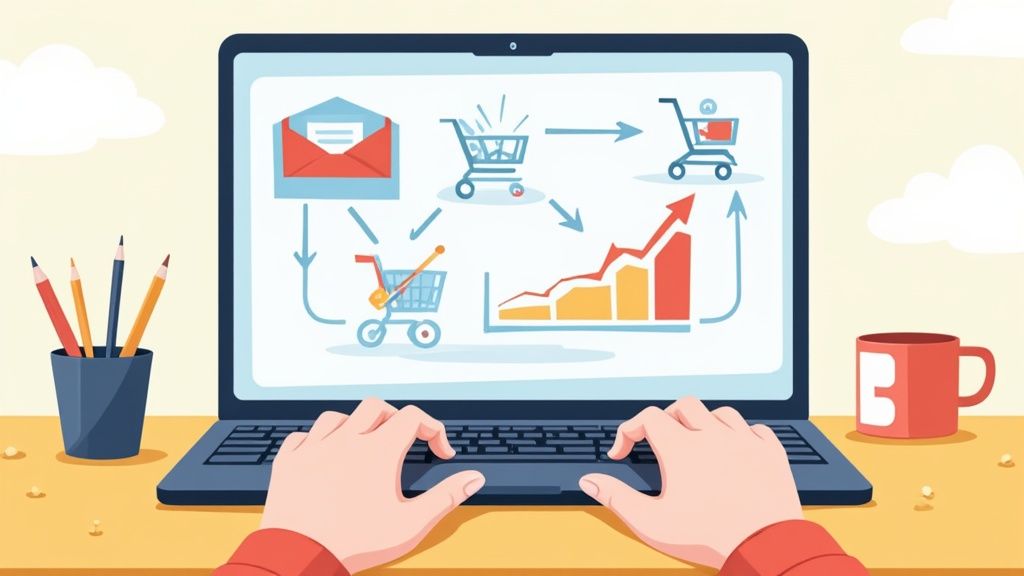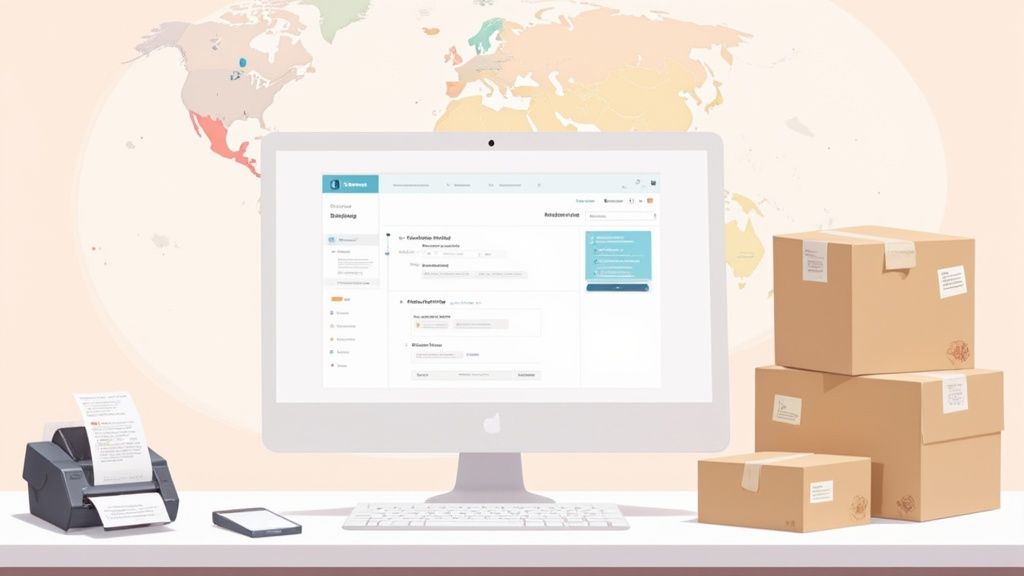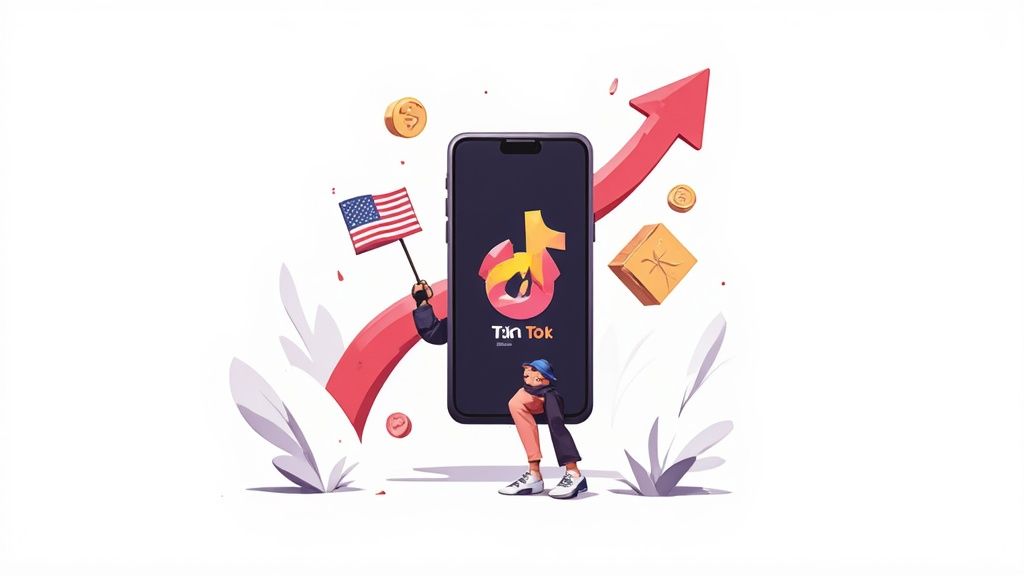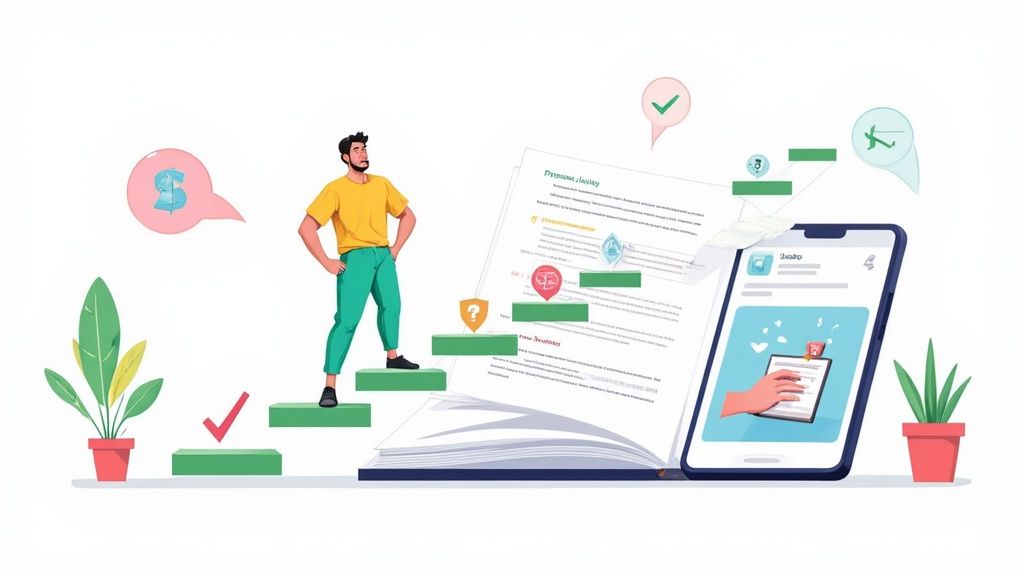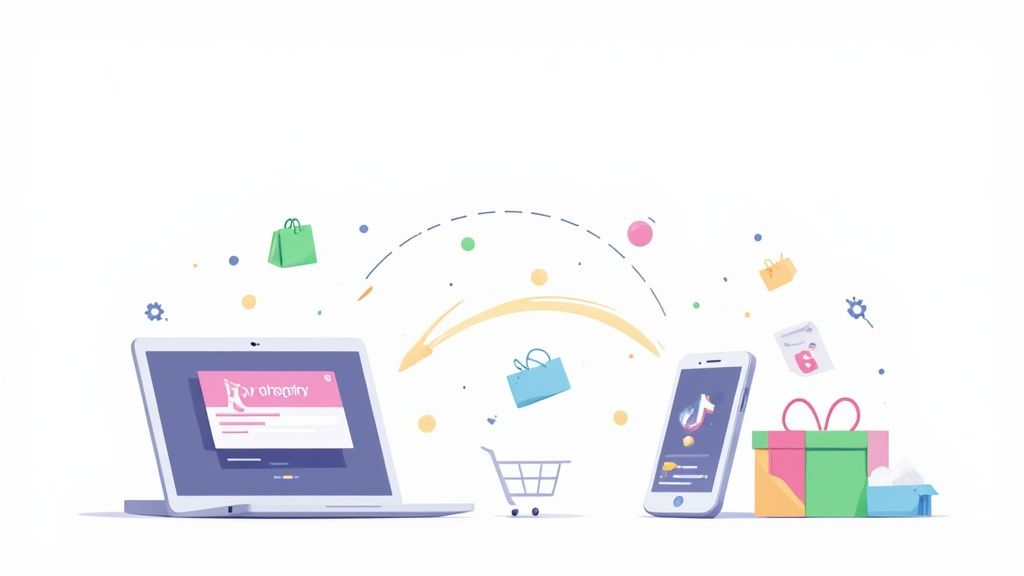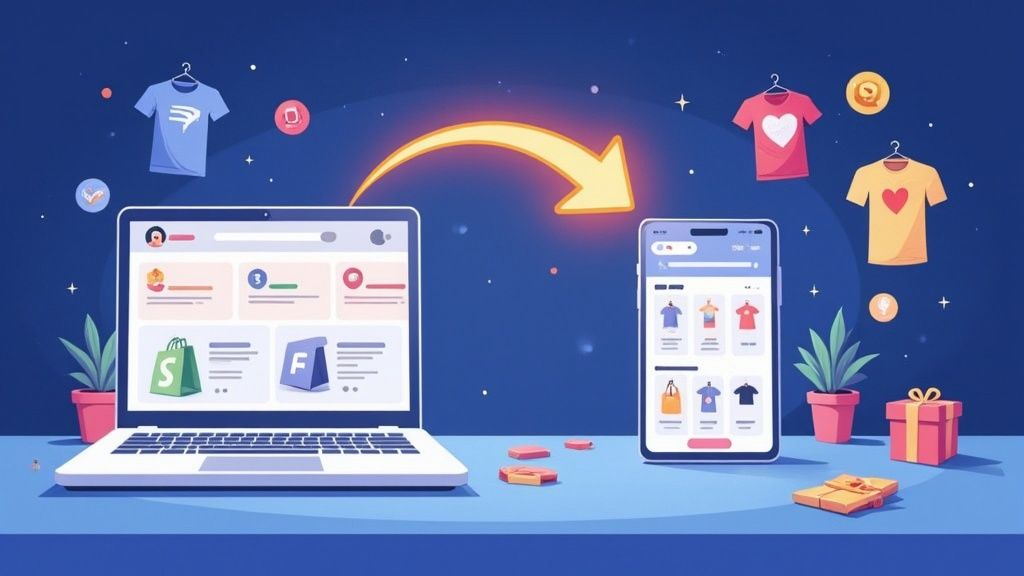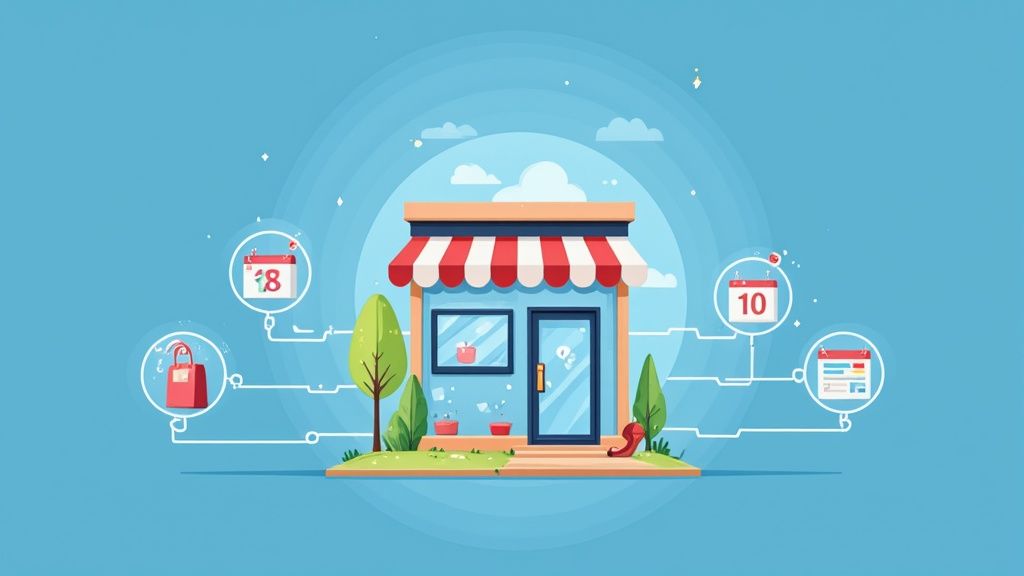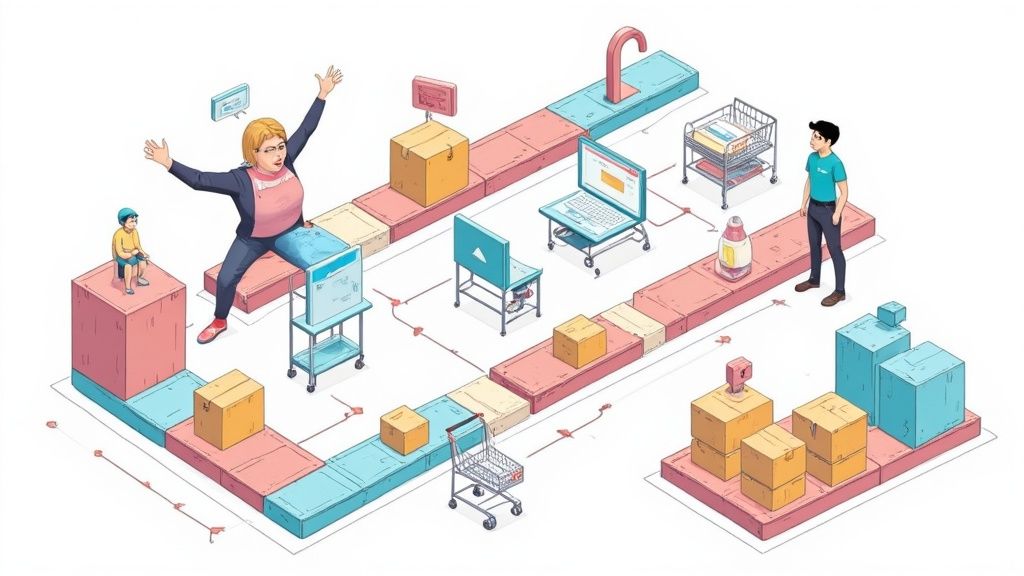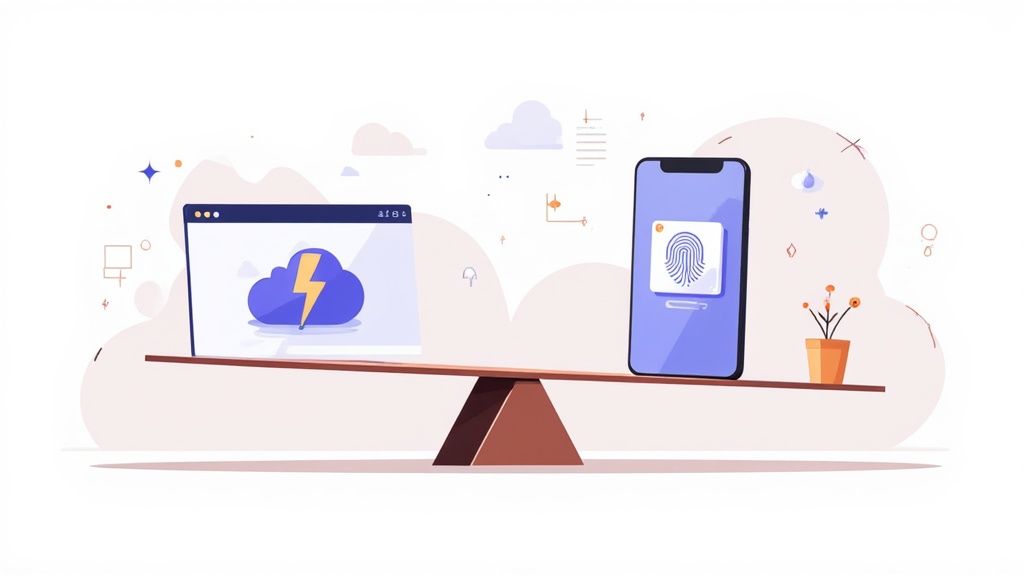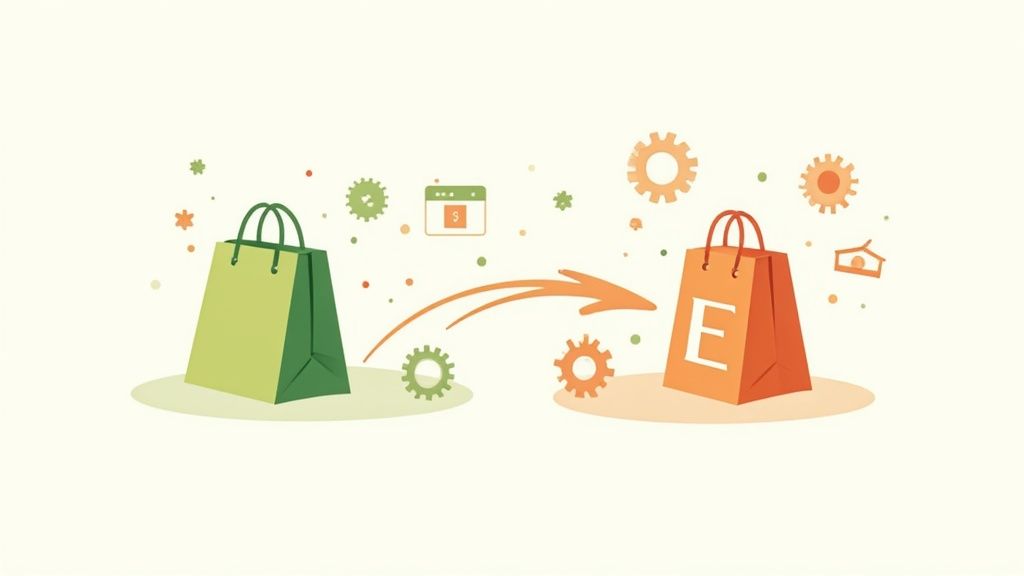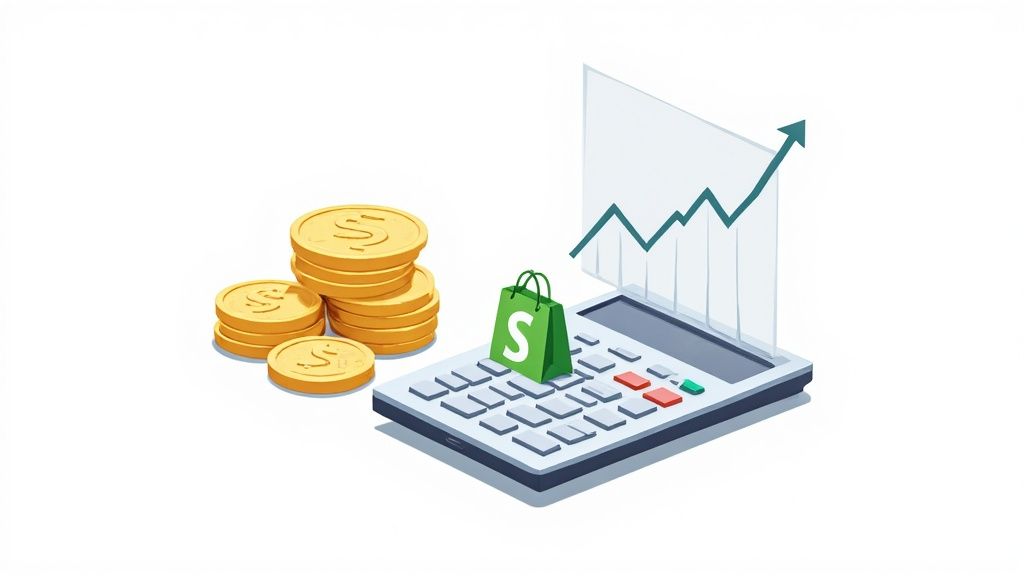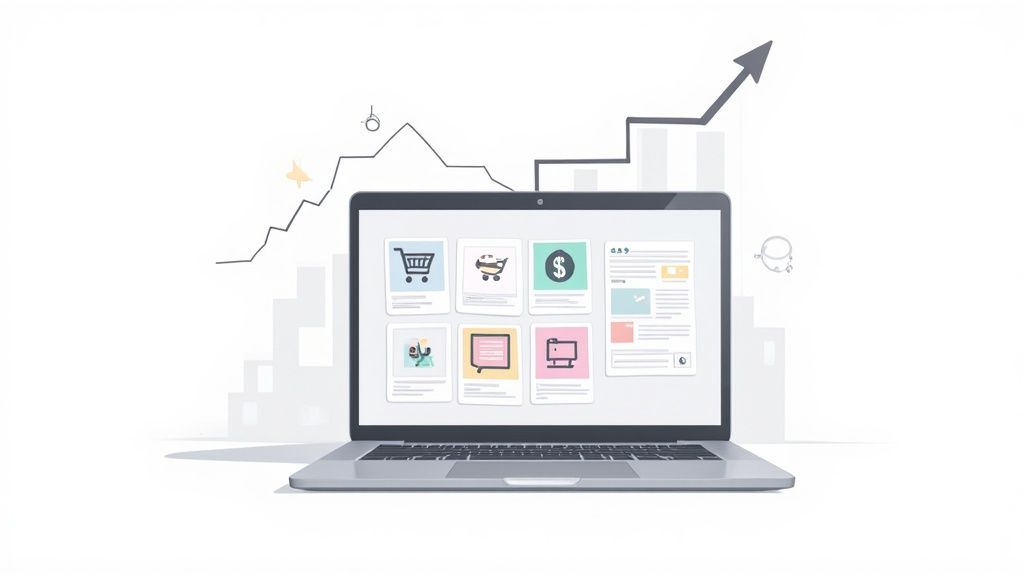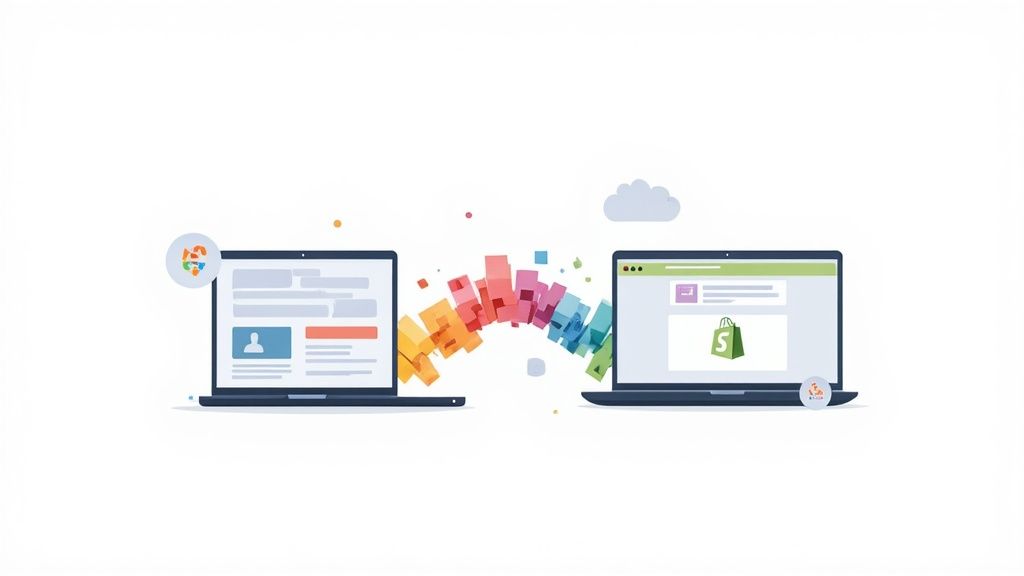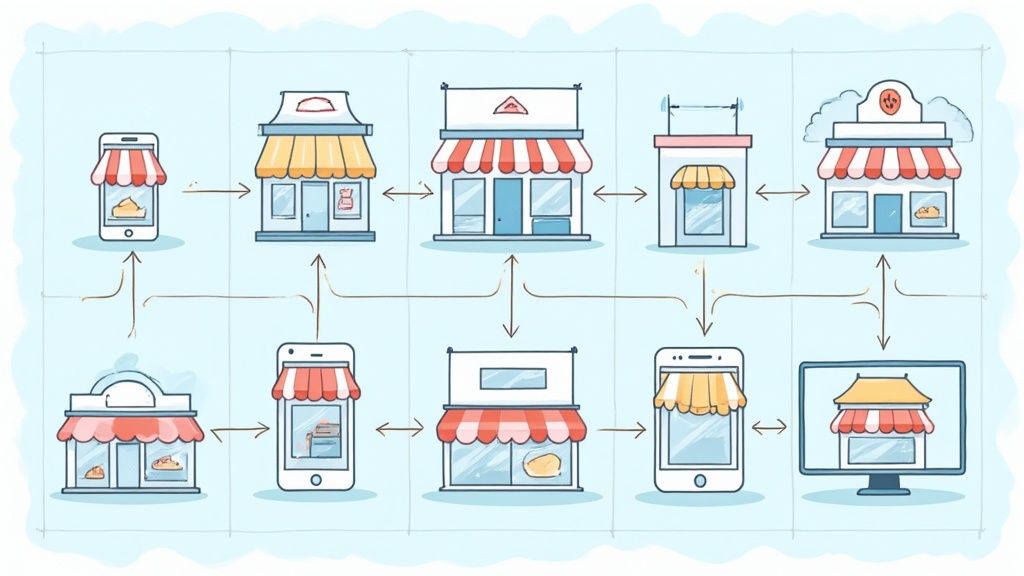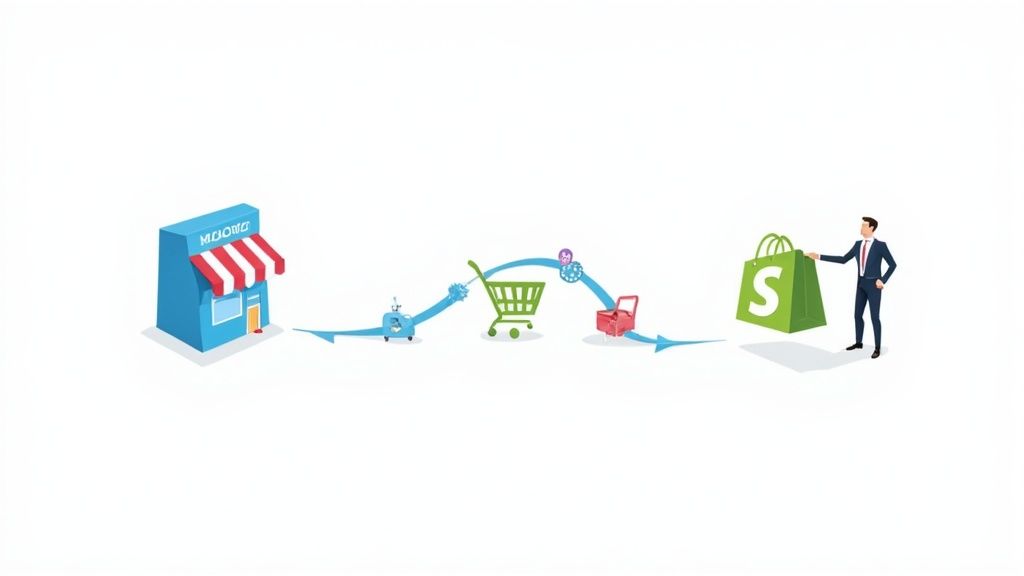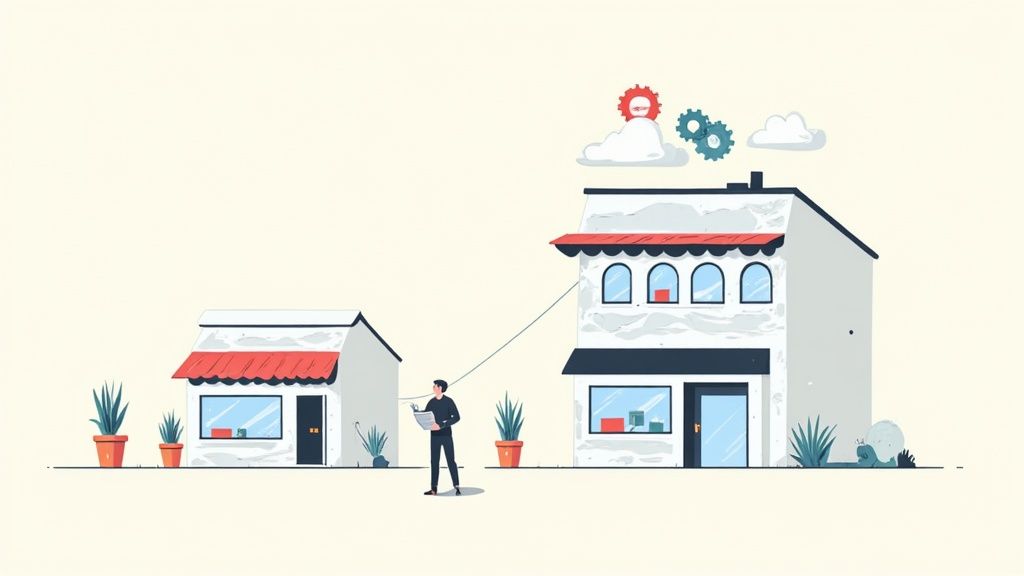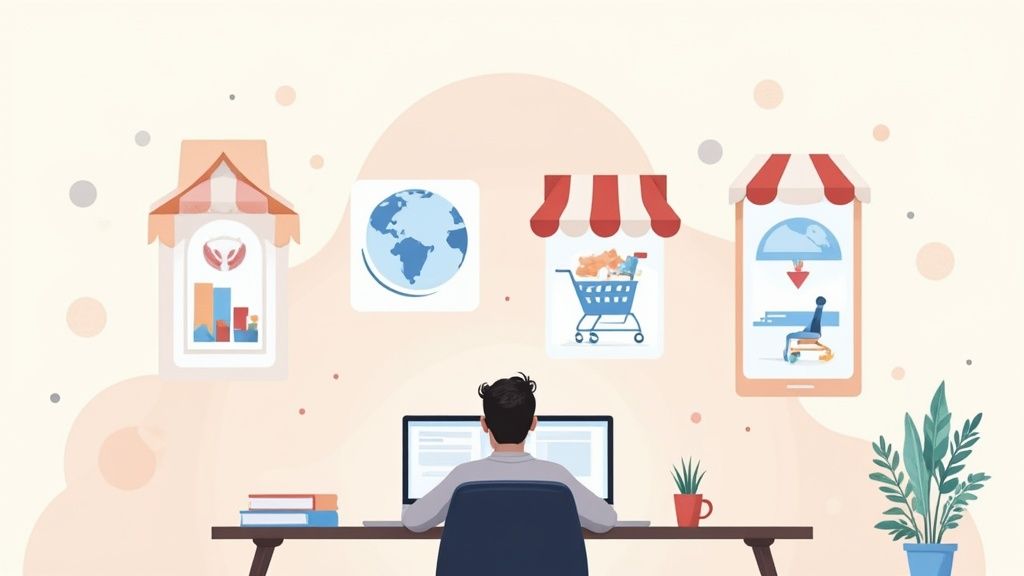
Thinking about running more than one Shopify store is a sign of some serious ambition. For a lot of successful brands, it's not just a thought bubble—it's a strategic necessity for scaling up, whether that means going international, splitting up different business models, or chasing entirely new audiences.
Deciding to Run More Than One Shopify Store

The choice to expand beyond a single storefront isn't about growing just for the sake of it. It’s about being precise. Moving from one store to many should be a calculated move that solves a real business problem or unlocks a clear opportunity. Before you even think about hitting that "create new store" button, you have to get brutally honest about why this is the right strategy for you.
This kind of expansion is a popular play in a massive ecosystem. As of mid-2025, there are over 5.5 million active stores on Shopify worldwide. The platform commands over 10% of the global e-commerce market and a whopping 30% share in the United States alone. A lot of those merchants are managing multiple storefronts to hit different markets or segment their product lines. You can learn more about Shopify's market presence and its huge impact on global commerce.
Common Scenarios for a Multi-Store Strategy
The reasons for launching another Shopify store are as diverse as the businesses themselves. Let's walk through a few real-world situations where this approach just makes sense.
- Going Global: You're killing it in the US but have your sights set on the German market. A separate store lets you serve up content in German, set prices in Euros, and build marketing campaigns around local holidays and cultural moments. It’s a much cleaner approach than trying to cram multiple languages and currencies into one site.
- Splitting B2B and D2C: Your main store is geared towards direct-to-consumer (D2C) sales. Launching a second, password-protected wholesale (B2B) store lets you offer bulk pricing, different payment terms, and a streamlined ordering process for your business clients. This keeps your retail customers from getting confused by wholesale info they don't need.
- Building Distinct Brands: Let's say you sell high-end, minimalist home goods but spot an opening for a vibrant, playful line of kids' decor. A separate store with its own unique branding, messaging, and design prevents brand dilution. You get to speak directly to each audience in a way that resonates, without one brand's style watering down the other.
Key Takeaway: The question isn't "Can I run more than one Shopify store?" The real question is "What strategic goal will a new store help me crush?"
By nailing down a clear purpose from the get-go—whether it's conquering a new region, serving a different type of customer, or launching a totally new brand—you're setting your multi-store venture up for success. This focus gives each store a distinct mission, which prevents operational headaches and maximizes its potential. Without that clarity, you just risk creating more work for yourself with very little to show for it.
Choosing Your Multi-Store Management Structure
Once you’ve decided to run more than one Shopify store, you hit your first major fork in the road: how are you actually going to manage them all? This isn’t a small decision. The path you choose will shape your daily workflows, your ability to scale, and your bottom line for years to come.
You really have two main options here. You can either juggle completely separate Shopify accounts for each store, or you can bring everything under one roof with the Shopify Plus platform.
Picking the right structure is more of a strategic business decision than a technical one. In fact, thinking about it with a project manager's hat on can be incredibly helpful. Applying effective project management strategies from the start will help you build a solid operational foundation, no matter which path you take.
The Independent Accounts Method
The most direct way to get started is by simply creating a new, separate Shopify account for every store you launch. Each storefront operates in its own little world—complete with its own subscription, admin panel, theme, apps, and settings.
This gives you total autonomy. For example, your UK store can have a completely different set of apps and a unique design from your US store, with no overlap in customer data. It’s a clean, pay-as-you-go model that makes a lot of sense if your stores serve wildly different purposes or if you're just dipping your toes into a new market.
The downside? It gets messy, fast. Constantly logging in and out of different accounts to update products, check inventory, or pull sales reports becomes a serious time sink. What starts as a simple setup can quickly turn into a daily headache.
The Unified Shopify Plus Approach
If you're serious about expansion, Shopify Plus offers a much more elegant and powerful solution. It's the enterprise-level plan built for high-volume merchants and, crucially, for businesses running multiple storefronts.
With Shopify Plus, all your stores are consolidated under a single organizational dashboard. From one place, you can:
- Manage Staff Globally: Give your team members access to one, several, or all of your stores from a central user management hub.
- View Consolidated Analytics: Get that all-important bird's-eye view of how your entire brand is performing without having to manually stitch together a dozen spreadsheets.
- Clone Existing Stores: This is a game-changer. You can launch a new international or B2B store in a fraction of the time by duplicating an existing one.
Shopify Plus is built for scale. It transforms store management from a juggling act into a streamlined, centralized operation, which is why it's the preferred choice for many growing brands.
This image really drives home the trade-off between the revenue potential and the increased management load that comes with adding more stores.

As you can see, the revenue opportunity is huge, but it comes with a level of complexity that your operations need to be ready for.
The platform's own numbers tell a similar story. As of April 2025, while there are around 4.82 million Shopify stores globally, a solid 52,757 of them are on Shopify Plus. This shows that for a significant chunk of serious merchants, the enterprise features aren't just a "nice-to-have"—they're essential for handling complex, multi-store operations.
Comparing Multi-Store Management Methods
So, which approach is right for you? It really boils down to a direct comparison of features and how they align with your business goals.
Here's a quick breakdown to help you decide:
Ultimately, the best structure comes down to your ambition. If your multi-store plan is small and your needs are simple, separate accounts might work for now. But if you have your sights set on building a brand empire, Shopify Plus provides the robust foundation you'll need to grow without being held back by operational friction.
Efficiently Setting Up Your Additional Stores
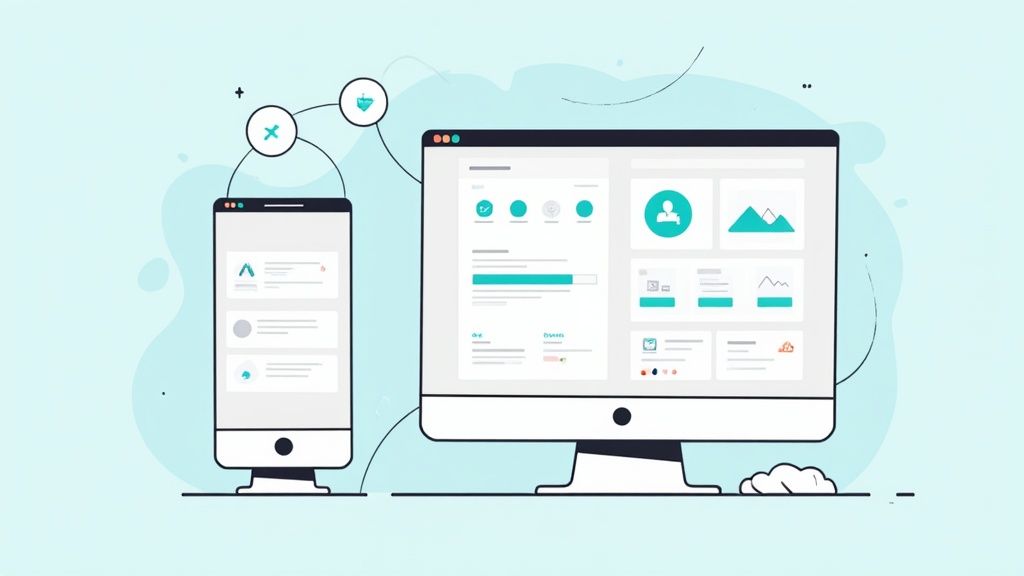
So, you're ready to launch another store. The thought of starting from scratch can be daunting, but it absolutely doesn't have to be. The secret to managing more than one Shopify store without completely burning out is to build a repeatable, efficient setup process. Think of your primary store as your master template—a blueprint you can use to get new storefronts off the ground in a fraction of the time.
If you happen to be on Shopify Plus, you're in luck. You have a massive head start thanks to the store cloning feature. It lets you duplicate an existing store, bringing over everything from the theme and navigation to many of your app configurations. This one tool can literally shrink your setup time from a few weeks down to just a couple of days.
For everyone else on standard Shopify plans, the process is a bit more hands-on, but you can still create a system. Your first move should be to download the theme from your main store and simply upload it to the new one. Just like that, your core design and layout are in place, giving you a solid foundation to build upon.
Tailoring Your Branding and Design
With the theme ready to go, it's time to give the new store its own personality. This is a critical step, whether you're expanding into a new country or targeting a totally different customer niche. A common mistake I see is merchants just swapping out the logo and calling it a day. Real brand differentiation goes much deeper than that.
Your branding to-do list should look something like this:
- Logo and Favicon: These are the obvious ones. Update them to reflect the new store's unique brand or regional identity.
- Color Scheme: Dive into your theme settings and tweak the primary and secondary colors. This is an easy way to create a distinct visual mood. For example, a U.S. store might rock a bold, vibrant palette, while its European counterpart could feel more sophisticated with muted, earthy tones.
- Typography: You want to maintain some brand consistency, of course, but subtle shifts in typography can help set your stores apart.
- Imagery: This is a big one. Replace your homepage banners, collection images, and lifestyle photos with visuals that will actually connect with your new audience.
Following these steps ensures each store feels like a unique, curated experience while still being instantly recognizable as part of your larger brand family.
Configuring Core Store Settings
Now that the front-end looks the part, it’s time to get into the backend settings. This is where you'll wire up all the operational nuts and bolts for the new storefront. Again, have your primary store open in another tab as a reference so you don't miss any crucial details.
Here are the key settings you absolutely have to configure:
- Payment Gateways: Set up the payment providers that make sense for the new market. If you're launching a Canadian store, that means adding options like Interac. For a German store, you'd want to have Giropay or Klarna available.
- Shipping Zones and Rates: This is arguably one of the most critical parts of the setup. You need to create new shipping zones for the countries your store will serve, with rates calculated in the local currency. Don't just copy and paste your old rates; check with your couriers to verify the pricing for that specific region.
- Taxes: Properly configure the tax settings based on the new store's location and the regions it will sell to. Getting this right from the start is vital for staying compliant and avoiding major financial headaches down the road.
Pro Tip: Do yourself a huge favor and create a detailed setup checklist in a project management tool like Asana or Trello. Document every single step, from uploading the theme file to the final tax setting configuration. This turns a complicated project into a scalable, repeatable process you can use for every future store you launch.
This methodical approach is all about minimizing errors and ensuring a consistent, professional experience for customers across your entire brand ecosystem. For a deeper dive into the operational frameworks that make this all possible, you might want to check out our expert advice on how to manage multiple Shopify stores. The ultimate goal is to build a well-oiled machine that lets you expand your brand’s reach without creating a chaotic mess behind the scenes.
Building Your Centralized Operations Tech Stack
Juggling the daily operations for more than one Shopify store without the right systems is a recipe for pure chaos. I've seen it happen time and again: inventory gets out of sync, customer inquiries fall through the cracks, and manual data entry slowly becomes a full-time job.
To avoid this operational nightmare, you absolutely need a centralized tech stack. This is a carefully chosen set of tools that brings your key functions under one roof, creating a single source of truth for your entire business. It's not about just adding more apps; it's about being strategic.
This is especially critical for merchants managing stores across different regions. Think about it: Shopify's presence varies wildly by country. The United States is the giant, with approximately 2.67 million active Shopify stores. But then you have the United Kingdom with around 191,000 stores, and Australia and Germany with roughly 138,000 and 133,000, respectively. Many successful merchants run separate stores to cater to these unique markets, which makes centralized tools non-negotiable. You can dig deeper into these numbers with some great Shopify statistics and insights from Sumtracker.
Core Tools for Inventory and Order Management
Your first priority has to be synchronizing inventory. When you’re selling the same products across multiple storefronts, overselling becomes a massive—and costly—risk. A customer in your UK store could buy the last of an item just moments before someone in your US store tries to do the same. This leads to canceled orders, unhappy customers, and a logistical headache you just don't need.
A dedicated inventory management system (IMS) is the only real solution here. These platforms act as the central brain for all your stock levels.
- Real-Time Syncing: When an item sells on any store, the IMS instantly updates the available quantity across all other channels. No more manual adjustments.
- Multi-Warehouse Support: If you have stock in different locations, like a US warehouse and a European 3PL, a good IMS can track and manage levels for each one independently.
- Purchase Order Automation: Many systems can even be set up to automatically generate purchase orders when stock runs low, which is a lifesaver for preventing stockouts.
Key Insight: Without a centralized inventory system, you're not really running a multi-store business; you're just running multiple, disconnected businesses. True operational efficiency comes from a unified view of your assets.
Consolidating Your Customer Support
Just like inventory, your customer service can become completely fragmented. Trying to manage separate inboxes for your US, Canadian, and Australian stores is horribly inefficient and incredibly prone to error. A customer might email your US support address about an order from your AU store, leading to a ton of confusion and delays.
This is where a centralized helpdesk platform comes in. It pulls all customer communications—email, live chat, contact forms—from all of your sites into a single, unified dashboard.
- Unified Agent View: Your support team gets a complete picture of every customer interaction, no matter which store it came from.
- Automated Routing: You can set up smart rules to automatically assign tickets to the right team based on the store, language, or issue type.
- Shared Knowledge Base: Build one central knowledge base that your entire support team can rely on. This ensures consistent, accurate answers for customers everywhere.
By building out this kind of tech stack, you start to transform your operations from a scattered collection of manual tasks into a streamlined, automated machine. It not only slashes manual errors but also frees you and your team up to focus on what actually grows the business.
Smart Marketing and SEO for Multiple Stores

When you're running more than one Shopify store, your marketing and SEO game needs to evolve. What worked for a single store can quickly become a liability. The biggest mistake we see is brands simply copying and pasting content—product descriptions, blog posts, you name it—from one site to another. This is a huge red flag for search engines and can absolutely tank your rankings.
The key is to think strategically. Each store needs to stand on its own two feet, building its own authority and pulling in the right crowd. You have to move beyond a one-size-fits-all approach and give each storefront its own distinct voice.
Avoiding SEO Self-Sabotage
The single biggest landmine you can step on with multiple stores is duplicate content. When Google stumbles upon the exact same text on your brand-us.com and your brand-uk.com, it gets confused. It doesn't know which page is the original or which one to show in search results. The result? Neither of them ranks well.
For international stores, the technical fix is the hreflang tag. This little snippet of code in your site's header is a game-changer. It tells search engines, "Hey, show this English UK version to users in Great Britain, and show the English US version to users in the United States." It clears up all the confusion.
Getting this right isn't just a good idea—it's non-negotiable for any brand selling internationally. Before you dive in, it’s worth understanding the fundamentals of how to handle Shopify multiple storefronts to sidestep these common technical headaches.
Crafting Unique Content Strategies
While hreflang tags handle the technical side, they're only half the battle. To really win, each of your stores needs a unique content strategy that speaks directly to its audience. This is where you can get creative and build much stronger connections with different customer groups.
Here are a few ways to approach this:
- Persona-Driven Content: If one store targets budget-conscious students and another is for high-income professionals, their content should be worlds apart. Think different blog topics, a different tone of voice on social media, and even different angles for product descriptions.
- Targeted Keyword Research: Don't use the same keyword list for every store. Your Australian shop might chase terms like "board shorts" and "sunnies," while your Canadian one focuses on "winter parkas" and "toques" at the very same time of year.
- Localized Marketing Campaigns: Lean into regional holidays and cultural moments. A Fourth of July sale will crush it for your US store, but a Boxing Day promotion will be the big winner for your UK, Canadian, and Australian customers.
For businesses targeting specific regions, getting local search right is crucial. It’s a different beast than general SEO, but just as important. We’ve seen great results when brands follow solid advice on optimizing local SEO for multiple locations.
Key Insight: Don't think of your stores as clones. Think of them as siblings. They come from the same family brand but have their own unique personalities. Each one needs its own marketing plan to shine.
By giving each store a distinct purpose and voice, you turn a potential SEO nightmare into a massive marketing advantage. This is how you dominate multiple niches at once.
Here's the rewritten section, crafted to sound like it was written by an experienced human expert.
Common Questions About Juggling Multiple Stores
Deciding to run more than one Shopify store is a big move. Once you've got your strategy down, the day-to-day realities kick in and bring a whole new set of practical questions. I’ve seen merchants run into the same hurdles time and time again, so let's tackle some of the most common ones I hear.
Can I Use the Same Email for Multiple Shopify Stores?
Yes, you absolutely can. Think of your login as a master key for your entire Shopify empire. You can use a single email address to be the owner or a staff member on as many stores as you need.
When you go to log in, Shopify simply asks which store you want to work on for that session. It’s a small feature, but it’s a huge relief. It saves you from the nightmare of juggling a dozen different email accounts and passwords just to manage your own brand.
How Does Shopify Plus Simplify Multi-Store Management?
This is where Shopify Plus really earns its stripes. It’s built from the ground up for this exact scenario and makes managing everything so much cleaner. The biggest game-changer is the single organizational dashboard, which gives you a true bird's-eye view of your entire business.
From that one central hub, you can:
- Manage Users Centrally: Forget adding staff to each store one by one. You can grant access to one, some, or all of your stores from a single screen. It’s a massive time-saver.
- See Global Analytics: Get a unified look at how your entire brand is performing without having to export and stitch together reports from each individual store.
- Clone Stores: This is huge. You can launch a new international or regional store in a fraction of the time by duplicating an existing one.
- Automate Workflows: Access exclusive tools like Shopify Flow to build automated rules that run across all your storefronts, handling repetitive tasks for you.
Honestly, this centralization is the core reason brands upgrade. It takes multi-store management from a frantic juggling act to a streamlined, cohesive operation. If you're serious about scaling, it's pretty much essential.
What Is the Best Way to Sync Inventory Across Stores?
The only truly reliable way to do this is with a dedicated inventory management system (IMS). While each of your Shopify stores has its own inventory count, an IMS acts as the single source of truth for your actual stock levels.
These systems plug into all of your stores and sync inventory changes in real time. So, when someone buys a T-shirt from your US store, the available quantity is instantly updated on your UK and Canadian sites. It's the only way to reliably prevent overselling, which is a fast track to cancelled orders and frustrated customers. I've seen great results with proven tools like Skubana, Cin7, or DEAR Systems—they’re built for exactly this challenge.
Will Multiple Stores for the Same Brand Hurt My SEO?
It can, but only if you get lazy. The biggest landmine here is duplicate content. If you just copy and paste all your product descriptions and blog posts from one store to another, search engines like Google will get confused. They won't know which site to rank and might just penalize both.
The key is to make sure each store has unique content tailored to its specific audience. For international stores, this means using hreflang tags to tell Google which regional version of a page should be shown to users in different countries. Always put in the effort to write distinct copy for each site. It’s the safest path forward and the most effective way to build authority for each store on its own terms.
Ready to build a high-converting, scalable foundation for your brand's growth? The team at ECORN specializes in Shopify development, design, and CRO to help businesses thrive. Whether you need help setting up your first additional store or optimizing a complex multi-store ecosystem, we have the expertise to make it happen. Explore our flexible packages and see how we can help you scale.








